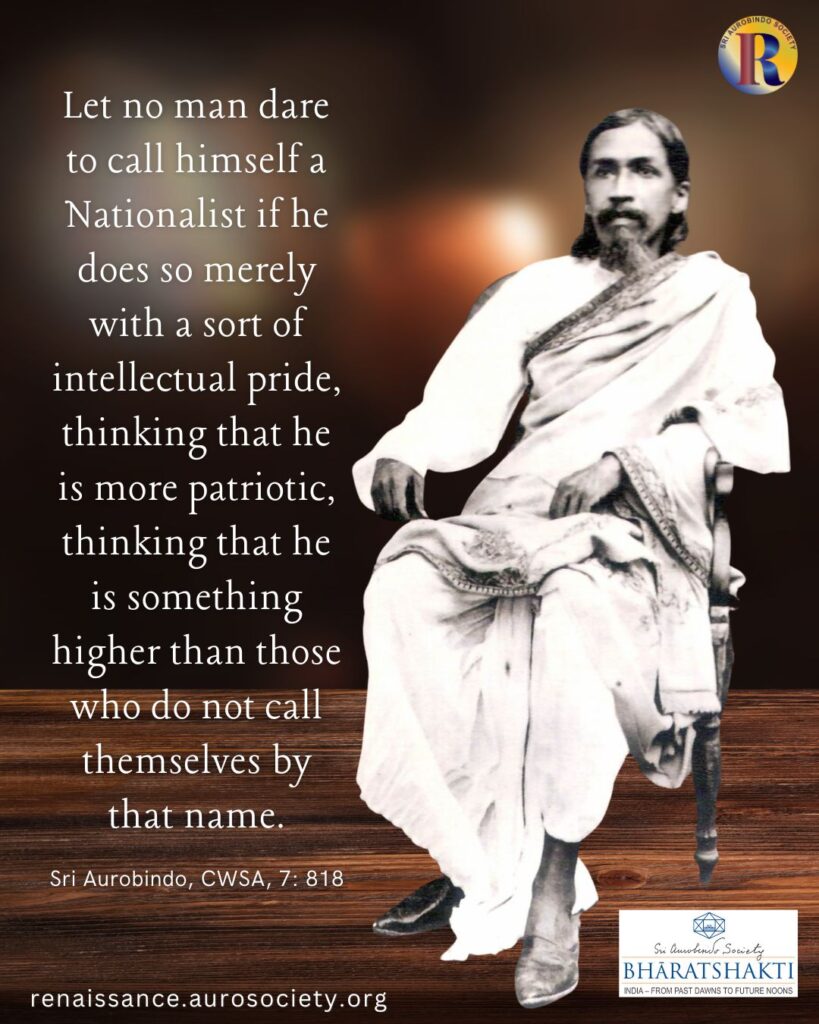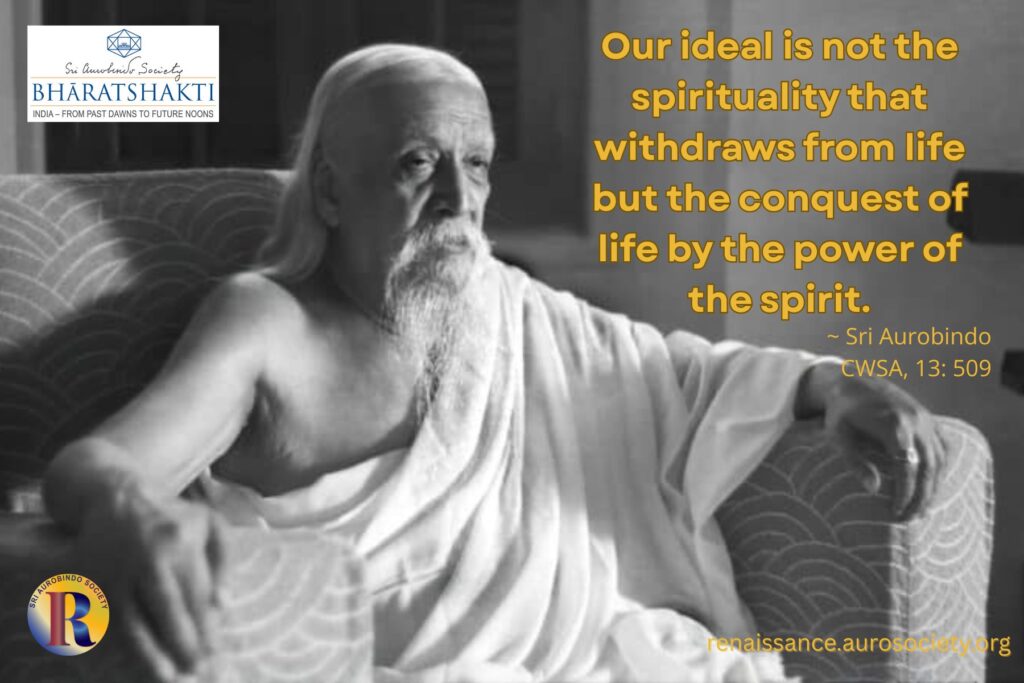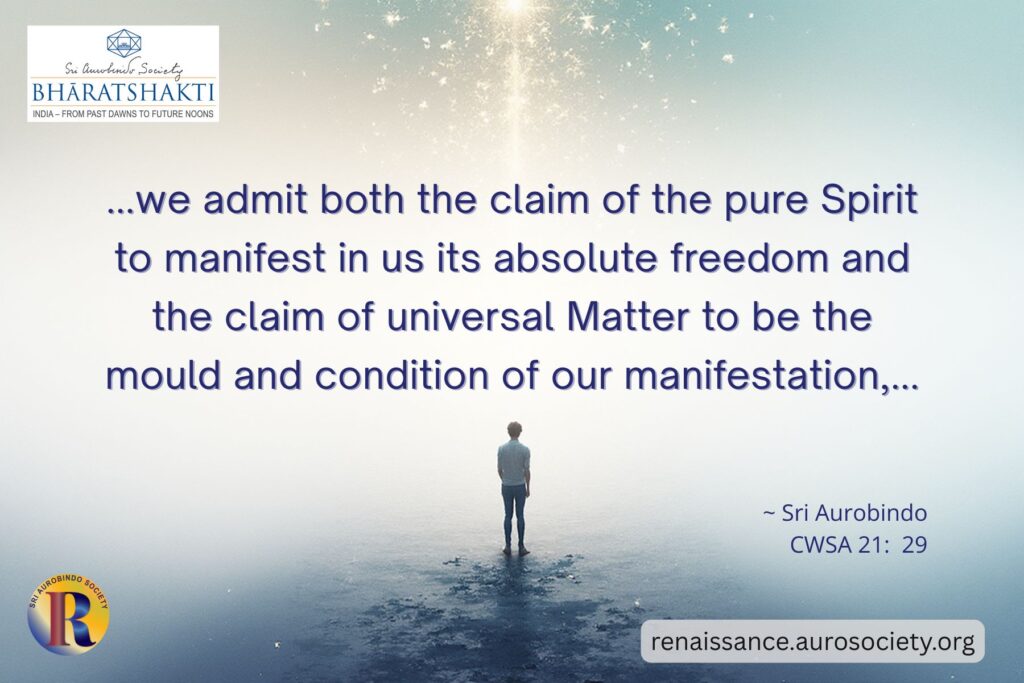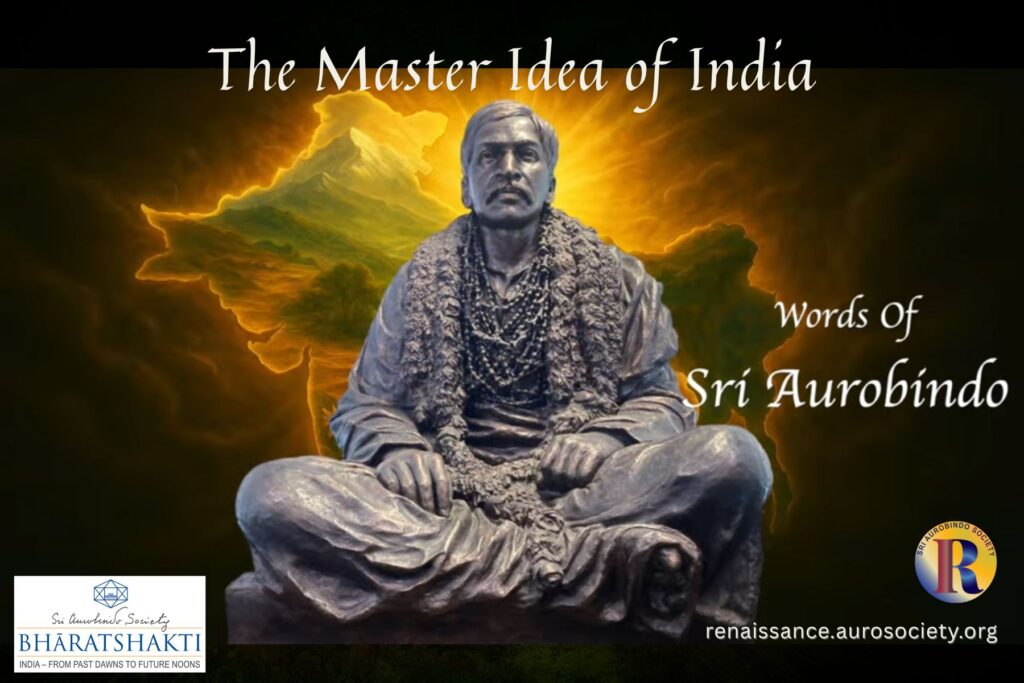Volume VI, Issue 7-8
Author: Sunil Kumar
Editor’s Note: The author helps us reimagine a new India as he highlights a few key insights from Sri Aurobindo. He reminds us of the essential work that is necessary for the rebirth of India’s timeless spirit in new forms.

A civilisation does not die on the battlefield; it dies when it forgets how to imagine.
India today clings to memory but loses meaning. While we frequently boast of past achievements, the vibrant essence of that worldview remains concealed beneath the veneer of borrowed phrases and contemporary worries.
As Sri Aurobindo foresaw, the burning crisis of India is not external subjugation, but internal confusion. Nationalism without soul, modernity without metaphysics, pride without purpose. Rather than dwelling on past greatness, civilisations thrive by reinterpreting and reinventing it. We do not lack knowledge; we lack vision. And drishti is the very essence of Dharma.
In his encyclopedic works, Sri Aurobindo has often warned us about this fate. Of a proud mind turned brittle, trapped in the relics of a luminous past. The question is no longer what we remember, but how we awaken the sleeping giant within.
You call yourselves Nationalists. What is Nationalism? Nationalism is not a mere political programme; Nationalism is a religion that has come from God; Nationalism is a creed in which you shall have to live. Let no man dare to call himself a Nationalist if he does so merely with a sort of intellectual pride…You must remember that you are the instrument of God for the salvation of your own country. You must live as the instruments of God…
~ Sri Aurobindo, CWSA, 7: 818-819
Also read:
The Ideal of Indian Nationalism

India’s civilisational ethos, shaped by a plural past and sustained by dharmic continuity, has endured a million assaults on its soul. She has withstood a million mutinies rising from within. Yet, she has remained, against all odds, a society of inner order rather than imposed uniformity.
However, today, a deracinated majority, unmoored from its own intellectual and spiritual lineage, often finds itself recycling borrowed ideas and chasing contemporary fashions. Nearly eighty years after independence, we still grapple with a very diluted, ossified and Eurocentric construct of soft power and hard power.
India must actively counter this drift by reclaiming intellectual depth and integrative analysis. These are the true hallmarks of her civilisational tradition, not an unthinking mimicry of borrowed paradigms. The originality and breadth of Sri Aurobindo’s worldview can be helpful.
I write, not for the orthodox, nor for those who have discovered a new orthodoxy, Samaj or Panth, nor for the unbeliever; I write for those who acknowledge reason but do not identify reason with Western materialism; who are sceptics but not unbelievers; who, admitting the claims of modern thought, still believe in India, her mission and her gospel, her immortal life and her eternal rebirth.
~ CWSA, 12: 63
Sri Aurobindo never called for an outright rejection of modern scientific thought. But he believed that material reductionism, devoid of its philosophical moorings, was shallow. In the current context, it is not a critique of modernity per se, but borrowed modernity bereft of a larger spiritual vision.
The invocation of archetypes such as Bhavani Bharati, Savitri and the Aryan ideal is a call to action. They are psychic maps that seek the rejuvenation of the Bharatiya ethos. They are an awakening call to bring the Indian mind from the tamas or inertia it finds itself in. In Sri Aurobindo’s view, India’s past becomes meaningful only when recast in terms of the soul’s evolution and as a harbinger of divinity.
Intellect has done many things for man; it has helped to raise him high above the animal; at its best it has opened a first view on all great fields of knowledge. But it cannot go beyond that; it cannot get at Truth itself, only at some reflections, forms, representations of it.
~ Sri Aurobindo, CWSA, 28: 346

***
The West and China are building machines that seek to redefine consciousness and its parameters, pushing us further to a soulless, nihilistic void and the incessant gratification of humanity’s basest instincts. It is incumbent for India to redefine consciousness architectures.
Systems of inner growth — the mind, emotion, spirit, journey of the soul have always been among the Indic system’s fundamental strengths. Instead of blindly copying Western fads, India should lead the world in building holistic and integral systems of inner growth. We should build schools that teach how to live well, how to concentrate, find peace and live with meaning based on Bharat’s rich heritage and the discursive analysis. Our curriculum should present contemporary relatability of ancient schools of thought such as Yoga, Samkhya, Vedanta, Tantra et al.
READ:
Sri Aurobindo on the Aryan Ideal of Courage
Sri Aurobindo urged us to leap into the intuitive realm rather than conforming to the limiting constraints of the analytical mind and its straitjacketed worldview. In his work ‘A Rationalist Critic of Indian Culture’, he mentions that all great civilisations move through an archetypal rhythm. First, a fluid, creative emergence occurs. Then, a period of consolidation where forms, rituals, and ideas are codified; and finally, a slow disintegration, where those once-living forms become hollow, repeated without meaning.
But history is not always a straight descent into ruin. At every threshold, there is the possibility of renaissance. It is the courage to awaken the inner fire, reinterpret truths and begin imagining again. The Vedic concept of Agni as Jatavedas, the all-knowing one, is used metaphorically by Sri Aurobindo to represent spiritual growth, transformation, and self-reinvention.
Decline, then, is not destiny. It is the test of a soul that still breathes beneath the surface.
The threats today are not merely military or political. They are epistemic and psychological. Ideas, as well as armies, can colonise a civilisation. There is a need to resist the unthinking digestion of profound ideas into a bland universalism devoid of substance and profundity. Recast and repackaged, they are lapped up by the same people who came up with it in the first place. Appropriation is now a fine art.
Although this flippant approach to Indic concepts is commonplace, an overtly combative posture reeks of parochialism. The latter sometimes turns ancient constructs into a golden-age myth. Sri Aurobindo’s cosmic vision emphasises the evolution of planetary consciousness, transcending limited geographical boundaries.
Only when man has developed not merely a fellow-feeling with all men, but a dominant sense of unity and commonalty, only only when he is aware of them not merely as brothers,—that is a fragile bond,—but as parts of himself, only when he has learned to live not in his separate personal and communal ego-sense, but in a larger universal consciousness can the phenomenon of war, with whatever weapons, pass out of his life without the possibility of return.
~ CWSA, 25: 611

With the recovery of Indic categories of thought — Dharma, Ṛta, we can reawaken the Bharatiya imagination in its voice, not through borrowed idioms. They must cease to be museum relics or poetic abstractions, but operative principles reflected in how we approach education, justice, design and run institutions or even define success.
For the civilizational renaissance to be real, it should not speak only to a rarefied section, but to the youth in colleges, the homemaker and the remote farmer. Seep into the texture of their lives. The universal light of consciousness, which Sri Aurobindo often mentions as the cornerstone of India’s ethos, needs to replace the flawed constructs of Western universalism that remain shallow and accentuate divisions.
I believe the key difference is between superimposition, aggression, and an assertive, empathetically driven pursuit of framework reform for both Bharat and the world. The conscious pursuit of collaboration fosters both individual and collective progress.
The truths of the Veda and the vision of the supramental are not opposed to daily life — they are the very ground and the deep roots on which it stands. But we must articulate them in new idioms. Unless implementation is done in cinema, curriculum, code, and conversation, we risk creating a gulf between our highest ideals and lived realities.




